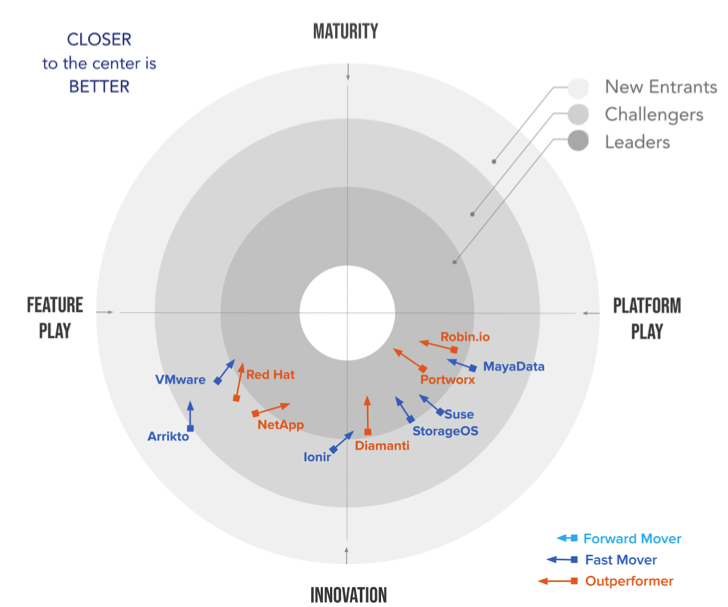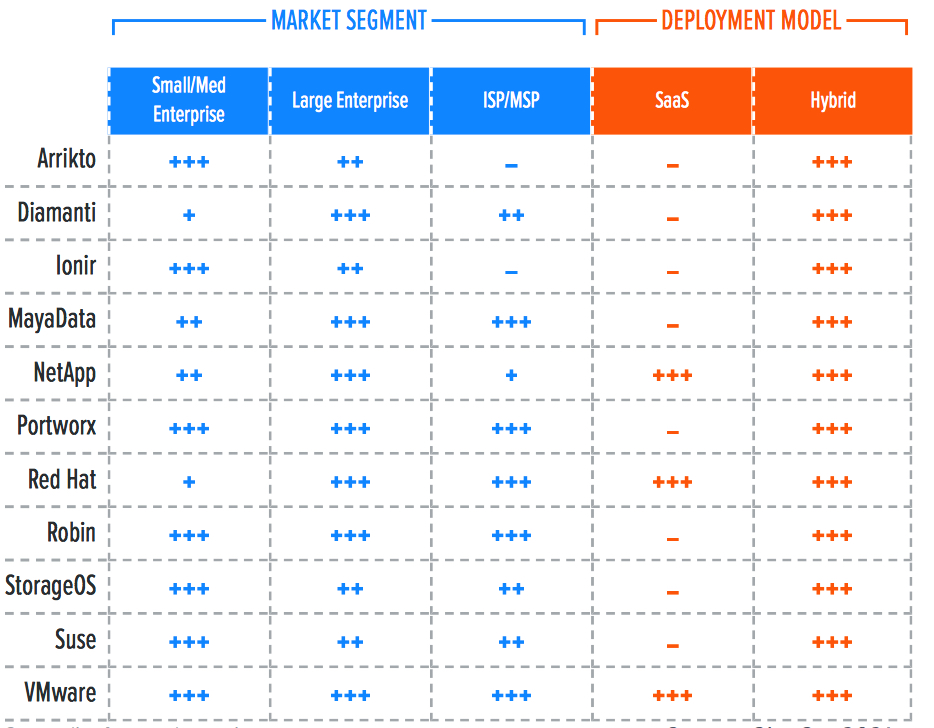GigaOm Radar for Cloud-Native Kubernetes Storage V2.0
Portworx/Pure Storage, Robin.io, and Diamanti nominated
This is a Press Release edited by StorageNewsletter.com on July 7, 2021 at 2:33 pmHere is an abstract of a report, published on June 25, 2021 and written by Enrico Signoretti and Max Mortillaro, analysts, for GigaOm. It is available on the web site of Portworx, Inc., acquired by Pure Storage last year.
GigaOm Radar for Cloud-Native Kubernetes Storage V2.0
Summary
This report focuses on cloud-native persistent storage solutions for Kubernetes. These are novel architectures specifically designed to address the needs of cloud-native applications without compromising on performance or scalability. They are usually not engineered to co-exist with other workload types, such as virtualization.
The adoption of cloud-native development frameworks and application refactoring initiatives continues to fuel demand for Kubernetes persistent storage. Organizations understand that the benefits of cloud-native workloads in terms of performance, scalability, and portability are key enablers to achieve business goals.
During the Covid-19 pandemic, enterprises already running cloud-native workloads met the abrupt challenges brought forth by lockdown measures with relative ease: application portability enables frictionless workload movement from the data center to the cloud, and even across clouds, providing greater flexibility and responsiveness to business requirements than using legacy technologies.
Since last GigaOm’s report, evaluated solutions have evolved at a rapid pace. Some vendors have been adding broad sets of enterprise-grade features to their products, while others have focused on supporting specific use cases.
Many users are adopting Kubernetes solutions after trying traditional enterprise storage first. The latter is usually considered a safe bet for first deployment but it can’t cope with the sheer number of backend operations required by Kubernetes at scale. This, together with the complexity involved in managing multi-cloud environments with traditional storage, encourages users to look for smarter and more efficient alternatives.
When compared to other types of systems, Kubernetes-native storage offers an environment that is more DevOps-friendly, helping to build a hardware stack that can be controlled by the operations team while enabling developers to allocate and monitor resources quickly, in a self-service fashion, when necessary. This is a major boon for enterprise IT organizations looking for the smartest way to evolve their processes and align them with the latest business and technology requirements.

The GigaOm Radar plots vendor solutions across a series of concentric rings, with those set closer to center judged to be of higher overall value. The chart characterizes each vendor on 2 axes – Maturity vs. Innovation, and Feature Play vs. Platform Play-while providing an arrow that projects each solution’s evolution over the coming 12 to 18 months.
As you can see in the Radar chart above, cloud-native Kubernetes storage solutions are very innovative and dynamic, which explains why there are no vendors at all in the upper part of the diagram, which usually denotes mature solutions.
In the lower right corner are 6 vendors with a platform approach. At the top of the pack are two with a strong enterprise approach to Kubernetes storage. Portworx, now owned by Pure Storage, leads this year’s radar thanks to the completeness of its platform, strong enterprise-grade capabilities, and excellent manageability. Robin.io, a platform with outstanding advanced data services and an application-centric approach to containers, follows closely.
Trailing slightly are Diamanti and StorageOS. Diamanti combines high resilience, performance, and simplicity of use with very good enterprise-grade features. StorageOS delivers high-performance Kubernetes storage for business-critical applications, thanks to its robust and scalable architecture.
Still in the lower right quadrant, 2 challengers are on a good course to join the leaders. Interestingly, both are open source projects. Longhorn, originally developed by Rancher Labs and recently acquired by SUSE, is now a CNCF sandbox project. This solution offers a flexible and performance-oriented architecture with growing advanced data services capabilities. The other one, OpenEBS, was originally developed by MayaData and gets contributions both from this company and a vibrant developer community. OpenEBS is a versatile solution with multiple deployment options and a focus on performance. Both solutions are built on solid and scalable architecture with great performance. However, enterprise-grade capabilities are not yet as developed as those of the other contenders in this section of the radar.
Ionir is a vendor with an intriguing trajectory: the company is crossing from feature play to platform play, and is on its way to becoming a leader. This solution has a strong focus on advanced data services and superior data management and data mobility capabilities due to its unique storage architecture and replication features.
The lower left corner of the radar shows 5 vendors, each of which are oriented more toward specific features, deployment models, or niche use cases.
VMware is a leader in this sector with VMware Tanzu. An excellently engineered solution, it offers the most convenient path to cloud-native Kubernetes storage for enterprises with a strong VMware footprint and large on-premises infrastructure, although Tanzu also runs on the cloud. Tanzu offers strong enterprise-grade features and excellent management capabilities that provide the fastest path to Day 2 operations for large enterprises.
Running alongside VMware, Red Hat OpenShift Data Foundation (ODF) is an enterprise-grade solution that boasts a rich set of capabilities. Unfortunately, ODF only supports OpenShift and therefore lacks the breadth of scope required to be positioned in the right (Platform Play) sector. Nevertheless, OpenShift users will find a compelling storage solution in ODF.
NetApp is interesting. Astra, its cloud-native as-a-service Kubernetes storage offering, shines in many areas. Built on Trident and Cloud Volumes, the solution is not only robust but offers great capabilities and an application-centric architecture. Astra is great for organizations seeking excellent performance, although the lack of support for non-NetApp underlying storage is currently a limiting factor.
Arrikto is a solution focused on MLOps and ML models that offers an innovative architecture and strong performance for Kubeflow. Among the highlights of the solution are advanced snapshot capabilities that greatly reduce data staging times for ML training and tuning activities.
Vendor positioning

+++ Exceptional: Outstanding focus and execution
++ Capable: Good but with room for improvement
+ Limited: Lacking in execution and use cases
– Not applicable or absent














 Subscribe to our free daily newsletter
Subscribe to our free daily newsletter


